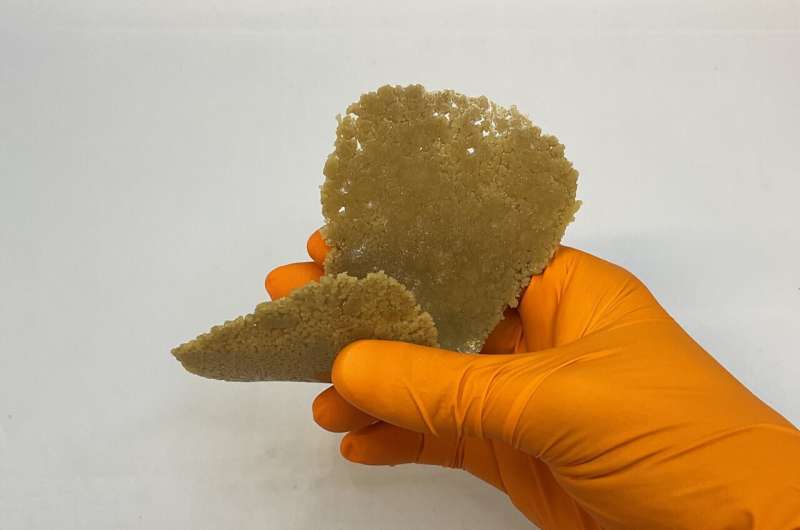This article has been reviewed according to Science X's editorial process and policies. Editors have highlighted the following attributes while ensuring the content's credibility:
fact-checked
trusted source
proofread
Is food waste the key to sustainable, plastic-free diapers and sanitary pads?

Once thrown away, disposable items such as diapers and sanitary pads can take hundreds of years to decompose, because their absorbent parts and waterproof layers contain plastics and other synthetic polymers. But now, researchers are replacing these materials with porous components made from protein biomass that is often discarded by the food and agricultural industries. These components are sustainable and biodegradable, and could potentially allow future diapers and sanitary pads to be flushed down a toilet or used as fertilizer.
The researchers will present their results today at the spring meeting of the American Chemical Society (ACS).
Antonio Capezza, who will present the research at the meeting, says that in Europe, regulations discourage the use of certain petroleum-based plastics in disposable goods. However, there aren't clear guidelines or regulations to ban these plastics in diapers, sanitary pads and other disposable sanitary items, he notes, because a good replacement hasn't been available.
"But we're hoping to change that with our protein-based materials," he says.
Of course, washable diapers avoid the plastics issue altogether, but he says that few caregivers want to use them. He is aiming to provide a different type of sustainable, non-polluting solution to people who want to continue using disposable sanitary products.
"The acceptance rate will be much higher than if you come to a customer and say, 'Okay, now you have to wash your diapers,'" explains Capezza, a researcher in the polymeric materials division at KTH Royal Institute of Technology in Sweden.
Ironically, the project had its origins in a demonstration designed to teach students what can go wrong in the lab. Capezza was showing them how to make bioplastic filaments using proteins. To mimic the impact of unwanted humidity, he added wet cotton, which caused the mixture to foam. Once the product dried, he realized, the material had become super porous, meaning it could sop up liquid like a sponge.
"So it was sort of an accident, but a good one, because that led us to an entirely new line of research," he says. Capezza is collaborating with researchers at KTH, the Swedish University of Agricultural Sciences, and other institutions, including Simón Bolívar University in Venezuela, the University of Tokyo in Japan and the University of Seville in Spain.
Some cotton-based alternatives to plastic sanitary products are already on the market, but they rely on virgin cotton and may need bleaching or other chemical treatment for their production. Looking for a more sustainable material source, Capezza's team identified proteins and other natural molecules left over from food and agricultural production that might otherwise be landfilled or incinerated; for instance, zein from corn, gluten from wheat and natural antioxidant extracts.
The researchers mixed the proteins together in different proportions and added water and bicarbonates, such as baking soda, as foaming agents; the sweetener glycerol as a plasticizer; and natural extracts as preservatives.
The team then used equipment and processing techniques from the plastics industry, including extrusion, to make various components commonly found in pads and diapers. Similar to a pasta maker, the extruder enabled the team to produce filaments and flat sheets while at the same time allowing them to foam the materials. With these techniques, the researchers produced a flat "nonwoven" layer that remained dry to the touch while allowing liquid to rapidly pass through; a fluffy porous material with superabsorbent properties that captured liquid; and waterproof films to protect outer garments.
As a proof of concept, the researchers assembled these components to make protein-based absorbent prototypes that resembled disposable sanitary products. Once exposed to water or soil, the materials completely biodegraded in a few weeks. Because of the materials' protein origin, this degradation released carbon, nitrogen, phosphorus, amino acids and other compounds that nature can reuse as nutrients.
With further development, Capezza says, this could lead to single-use sanitary products that can be flushed. Alternatively, after use, these products (or any waste produced at the manufacturing stage) could be composted to fertilize crops, such as corn and wheat, which would in turn provide the starting materials to make new sanitary products.
"So it's a fully circular design," Capezza adds. The researchers have already shown that plants grow longer leaves and roots when exposed to this compost. "And our tests have shown that because it's protein based, there's no risk whatsoever that these products will pollute the soil with microplastics or other unwanted chemicals when they break down," Capezza notes.
Protein-based sanitary products would be about 10% to 20% more expensive than traditional plastic diapers and pads, Capezza estimates. The performance of protein sanitary pads is similar to that of conventional pads. On the other hand, protein diapers aren't as absorbent as their plastic counterparts. That means protein diapers would either need to be thicker, or their formulation would need to be tweaked to improve absorption.
To boost liquid uptake and mechanical strength, the researchers are now exploring the addition of lignocellulose, a blend of lignin and cellulose that's found in plants. This material is a low-value byproduct of the farming and forestry sectors. Results to date show its addition is bringing performance close to that of conventional diapers.
The team is now preparing for pilot studies to test the feasibility of scaling up production. Additional evaluations, including human skin irritation tests, will need to be done before any of these products can go on the market, Capezza says.
Provided by American Chemical Society





















